Dynamic Influence Analysis of the Important Station Evolution on the Resilience of Complex Metro Network
Abstract
1. Introduction
2. Methodology
2.1. Complex Network Modeling and Node Centrality Measurement
2.2. Node Interruption Simulation
2.3. Resilience Evaluation Modeling
3. Research Object
4. Numerical Analysis Results
4.1. Dynamic Evolution Characteristics of Important Node Centrality
4.2. Resilience Evaluation of Metro Network under Important Node Failure
4.2.1. Network Characteristics under Important Node Failure
4.2.2. Resilience Evaluation and Recovery Strategy
4.3. Influences of Important Node Evolution on Metro Network’s Resilience
5. Conclusions and Future Works
- (1)
- SZMN gradually progresses from N1 to N2 and N3 over time, and the cost of transportation for citizens gradually decreases. The nodes are connected closer and closer together, and the global efficiency is growing inch by inch. Meanwhile, the information transmission capacity grows, and network accessibility continues to improve. With the growth of the network, node centrality values for CGM stations likewise progressively increase. and account for the highest proportion among the five centralities. Compared with other nodes, CGM stations play an increasingly important role in SZMN, which is strongly tied to how the topology has changed.
- (2)
- The topology of SZM networks (N1, N2, and N3) is clearly altered after the interruption of the CGM station, with both and growing larger and the network travel cost rising as well. Moreover, there is a little bit of difference in the network density and local efficiency . Correspondingly, the global efficiency of SZMN falls when compared to a normal network. On the whole, removing CGM had a stronger impact on N3 and a smaller impact on N1. Based on the proposed resilience evaluation model of the complex metro network, it can be concluded that there is only one recovery strategy for the general station interruption in N1, and the network resilience level and resilience loss are 0.9857 and 0.0018, respectively. CGM operates as a two-line transfer station in N2. After a complete failure, there are recovery options available, and the resilience is quantitatively 0.9451 and 0.9670, respectively. As a result, the preferred strategy is to regain L-11 first. When the network evolves to N3, there are recovery schemes after the interruption of CGM, among which the optimal recovery strategy is L-11/7/1/9, with the highest resilience of 0.9738. So, the metro management department can implement the appropriate management strategies to maximize network resilience and minimize loss.
- (3)
- Based on the topology evolution analysis of metro networks and important nodes, the WTPOSIS algorithm is adopted to quantitatively evaluate the comprehensive importance of all nodes. It can be concluded that the importance level of CGM in three networks is, respectively, , and , indicating that CGM is playing an increasingly important role in SZMN. Combined with the resilience evaluation results of a metro network facing the failure of CGM, the resilience level of SZMN decreases gradually declines over time, indicating that CGM stations have an increasing impact on the network. The metro management department should therefore increase the safety supervision of crucial stations in order to reduce the resilience loss brought on by deliberate attacks. The findings can provide certain guidance for the policies formulated in the daily operational management and future planning of the Shenzhen Metro, including key station or area management, controlling massive passenger flow, spatial planning strategy, etc. Combining with complex network theory, resilience theory, and metro management practice, the dynamic resilience influences of important node failure on metro network during the evolution of the network are explored, and the corresponding recovery strategies are discussed for different cases in this study, which helps to improve the robustness and recoverability of the entire metro network and reduce the vulnerability to emergencies. This study has significant theoretical and practical implications for the sustainable planning, construction, and safety management of the metro network. However, this study still needs to be enhanced in the aspects of network complexity and resilience evaluation model. In future research work, more factors will be considered, and an optimization algorithm will be proposed to improve the existing model. In-depth research will also be conducted on the metro network’s dynamic resilience under additional scenarios.
Author Contributions
Funding
Institutional Review Board Statement
Informed Consent Statement
Data Availability Statement
Conflicts of Interest
References
- Wang, Y.; Zhou, Y.; Yang, H.; Yan, X. Integrated Optimization of Bus Bridging Service Design and Passenger Assignment in Response to Urban Rail Transit Disruptions. Transp. Res. Part C Emerg. Technol. 2023, 150, 104098. [Google Scholar] [CrossRef]
- Wang, J.; Lu, Y.; Yang, Y.; Peng, J.; Liu, Y.; Yang, L. Influence of a New Rail Transit Line on Travel Behavior: Evidence from Repeated Cross-Sectional Surveys in Hong Kong. J. Transp. Geogr. 2023, 106, 103526. [Google Scholar] [CrossRef]
- Hu, H.; Li, J.; Wu, S. Simulation Evaluation of a Current Limiting Scheme in an Urban Rail Transit Network. Sustainability 2022, 15, 375. [Google Scholar] [CrossRef]
- Dou, F.; Zhang, H.; Yin, H.; Wei, Y.; Ning, Y. An Optimization Method of Urban Rail Train Operation Scheme Based on the Control of Load Factor. Sustainability 2022, 14, 14235. [Google Scholar] [CrossRef]
- Chen, T.; Ma, J.; Zhu, Z.; Guo, X. Evaluation Method for Node Importance of Urban Rail Network Considering Traffic Characteristics. Sustainability 2023, 15, 3582. [Google Scholar] [CrossRef]
- China Association of Metros the Overview of Urban Rail Transit Lines in Mainland China in 2022. Available online: https://www.camet.org.cn/xyxw/11484 (accessed on 1 March 2023).
- Chen, J.; Pu, Z.; Guo, X.; Cao, J.; Zhang, F. Multiperiod Metro Timetable Optimization Based on the Complex Network and Dynamic Travel Demand. Phys. A 2023, 611, 128419. [Google Scholar] [CrossRef]
- Kopsidas, A.; Kepaptsoglou, K. Identification of Critical Stations in a Metro System: A Substitute Complex Network Analysis. Phys. A 2022, 596, 127123. [Google Scholar] [CrossRef]
- Yu, X.; Chen, Z.; Liu, F.; Zhu, H. How Urban Metro Networks Grow: From a Complex Network Perspective. Tunn. Undergr. Space Technol. 2023, 131, 104841. [Google Scholar] [CrossRef]
- Song, J.; Abuduwayiti, A.; Gou, Z. The Role of Subway Network in Urban Spatial Structure Optimization—Wuhan City as an Example. Tunn. Undergr. Space Technol. 2023, 131, 104842. [Google Scholar] [CrossRef]
- Pei, A.; Xiao, F.; Yu, S.; Li, L. Efficiency in the Evolution of Metro Networks. Sci. Rep. 2022, 12, 8326. [Google Scholar] [CrossRef]
- Meng, Y.; Qi, Q.; Liu, J.; Zhou, W. Dynamic Evolution Analysis of Complex Topology and Node Importance in Shenzhen Metro Network from 2004 to 2021. Sustainability 2022, 14, 7234. [Google Scholar] [CrossRef]
- Ma, M.; Hu, D.; Chien, S.I.-J.; Liu, J.; Yang, X.; Ma, Z. Evolution Assessment of Urban Rail Transit Networks: A Case Study of Xi’an, China. Phys. A 2022, 603, 127670. [Google Scholar] [CrossRef]
- He, Y.; Xu, Z.; Zhao, Y.; Tsui, K.-L. Dynamic Evolution Analysis of Metro Network Connectivity and Bottleneck Identification: From the Perspective of Individual Cognition. IEEE Access 2019, 7, 2042–2052. [Google Scholar] [CrossRef]
- Zhang, Y.; Ng, S.T. Robustness of Urban Railway Networks against the Cascading Failures Induced by the Fluctuation of Passenger Flow. Reliab. Eng. Syst. Saf. 2022, 219, 108227. [Google Scholar] [CrossRef]
- Lu, Q.-C.; Zhang, L.; Xu, P.-C.; Cui, X.; Li, J. Modeling Network Vulnerability of Urban Rail Transit under Cascading Failures: A Coupled Map Lattices Approach. Reliab. Eng. Syst. Saf. 2022, 221, 108320. [Google Scholar] [CrossRef]
- Wang, Y.; Tian, C. Measure Vulnerability of Metro Network Under Cascading Failure. IEEE Access 2021, 9, 683–692. [Google Scholar] [CrossRef]
- Pan, S.; Yan, H.; He, J.; He, Z. Vulnerability and Resilience of Transportation Systems: A Recent Literature Review. Phys. A 2021, 581, 126235. [Google Scholar] [CrossRef]
- Qi, Q.; Meng, Y.; Zhao, X.; Liu, J. Resilience Assessment of an Urban Metro Complex Network: A Case Study of the Zhengzhou Metro. Sustainability 2022, 14, 11555. [Google Scholar] [CrossRef]
- Chen, C.; Wang, S.; Zhang, J.; Gu, X. Modeling the Vulnerability and Resilience of Interdependent Transportation Networks under Multiple Disruptions. J. Infrastruct. Syst. 2023, 29, 04022043. [Google Scholar] [CrossRef]
- Xu, Z.; Chopra, S.S. Network-Based Assessment of Metro Infrastructure with a Spatial–Temporal Resilience Cycle Framework. Reliab. Eng. Syst. Saf. 2022, 223, 108434. [Google Scholar] [CrossRef]
- Liu, Z.; Chen, H.; Liu, E.; Hu, W. Exploring the Resilience Assessment Framework of Urban Road Network for Sustainable Cities. Phys. A 2022, 586, 126465. [Google Scholar] [CrossRef]
- Capacci, L.; Biondini, F.; Frangopol, D.M. Resilience of Aging Structures and Infrastructure Systems with Emphasis on Seismic Resilience of Bridges and Road Networks: Review. Sustain. Cities Soc. 2022, 1, 23–41. [Google Scholar] [CrossRef]
- Hosseini, Y.; Karami Mohammadi, R.; Yang, T.Y. Resource-Based Seismic Resilience Optimization of the Blocked Urban Road Network in Emergency Response Phase Considering Uncertainties. Int. J. Disaster Risk Reduct. 2023, 85, 103496. [Google Scholar] [CrossRef]
- Sresakoolchai, J.; Hamarat, M.; Kaewunruen, S. Automated Machine Learning Recognition to Diagnose Flood Resilience of Railway Switches and Crossings. Sci. Rep. 2023, 13, 2106. [Google Scholar] [CrossRef]
- Yin, J.; Ren, X.; Su, S.; Yan, F.; Tao, T. Resilience-Oriented Train Rescheduling Optimization in Railway Networks: A Mixed Integer Programming Approach. IEEE Trans. Intell. Transport. Syst. 2023, 24, 4948–4961. [Google Scholar] [CrossRef]
- Ilalokhoin, O.; Pant, R.; Hall, J.W. A Model and Methodology for Resilience Assessment of Interdependent Rail Networks—Case Study of Great Britain’s Rail Network. Reliab. Eng. Syst. Saf. 2023, 229, 108895. [Google Scholar] [CrossRef]
- Montsiemang, T.; Dube, K. Post-COVID-19 Aviation Industry Recovery, Resilience, Challenges and Opportunities: A Focus on Western Cape Province, South Africa. In COVID-19, Tourist Destinations and Prospects for Recovery; Springer: Cham, Switzerland, 2023; Volume 2, pp. 243–259. [Google Scholar]
- Guo, J.; Yang, Z.; Zhong, Q.; Sun, X.; Wang, Y. A Novel Resilience Analysis Methodology for Airport Networks System from the Perspective of Different Epidemic Prevention and Control Policy Responses. PLoS ONE 2023, 18, e0281950. [Google Scholar] [CrossRef]
- Gu, B.; Liu, J. A Systematic Review of Resilience in the Maritime Transport. Int. J. Logist. Res. Appl. 2023, 1–22. [Google Scholar] [CrossRef]
- Shi, J.; Chen, J.; Xu, L.; Di, Z.; Qu, Q. Improving the Resilience of Maritime Supply Chains: The Integration of Ports and Inland Transporters in Duopoly Markets. Front. Eng. Manag. 2023, 10, 51–66. [Google Scholar] [CrossRef]
- Zhang, Z.; Chai, H.; Guo, Z. Quantitative Resilience Assessment of the Network-Level Metro Rail Service’s Responses to the COVID-19 Pandemic. Sustain. Cities Soc. 2023, 89, 104315. [Google Scholar] [CrossRef]
- Jiao, L.; Zhu, Y.; Huo, X.; Wu, Y.; Zhang, Y. Resilience Assessment of Metro Stations against Rainstorm Disaster Based on Cloud Model: A Case Study in Chongqing, China. Nat. Hazards 2023, 116, 2311–2337. [Google Scholar] [CrossRef]
- Zhang, J.; Ren, G.; Song, J. Resilience-Based Restoration Sequence Optimization for Metro Networks: A Case Study in China. J. Adv. Transp. 2022, 2022, 8595356. [Google Scholar] [CrossRef]
- Yin, J.; Ren, X.; Liu, R.; Tang, T.; Su, S. Quantitative Analysis for Resilience-Based Urban Rail Systems: A Hybrid Knowledge-Based and Data-Driven Approach. Reliab. Eng. Syst. Saf. 2022, 219, 108183. [Google Scholar] [CrossRef]
- Meng, Y.; Tian, X.; Li, Z.; Zhou, W.; Zhou, Z.; Zhong, M. Exploring Node Importance Evolution of Weighted Complex Networks in Urban Rail Transit. Phys. A 2020, 558, 124925. [Google Scholar] [CrossRef]
- Wang, W.; Wang, Y.; Wang, G.; Li, M.; Jia, L. Identification of the Critical Accident Causative Factors in the Urban Rail Transit System by Complex Network Theory. Phys. A 2023, 610, 128404. [Google Scholar] [CrossRef]
- Meng, Y.; Tian, X.; Li, Z.; Zhou, W.; Zhou, Z.; Zhong, M. Comparison Analysis on Complex Topological Network Models of Urban Rail Transit: A Case Study of Shenzhen Metro in China. Phys. A 2020, 559, 125031. [Google Scholar] [CrossRef]
- Freeman, L.C. Centrality in Social Networks Conceptual Clarification. Soc. Netw. 1978, 1, 215–239. [Google Scholar] [CrossRef]
- Freeman, L.C. A Set of Measures of Centrality Based on Betweenness. Sociometry 1977, 40, 35. [Google Scholar] [CrossRef]
- Li, J.; Zheng, P.; Zhang, W. Identifying the Spatial Distribution of Public Transportation Trips by Node and Community Characteristics. Transp. Plan. Technol. 2020, 43, 325–340. [Google Scholar] [CrossRef]
- Shen, Y.; Ren, G.; Ran, B. Cascading Failure Analysis and Robustness Optimization of Metro Networks Based on Coupled Map Lattices: A Case Study of Nanjing, China. Transportation 2021, 48, 537–553. [Google Scholar] [CrossRef]
- Chen, H.; Zhang, L.; Liu, Q.; Wang, H.; Dai, X. Simulation-Based Vulnerability Assessment in Transit Systems with Cascade Failures. J. Clean. Prod. 2021, 295, 126441. [Google Scholar] [CrossRef]
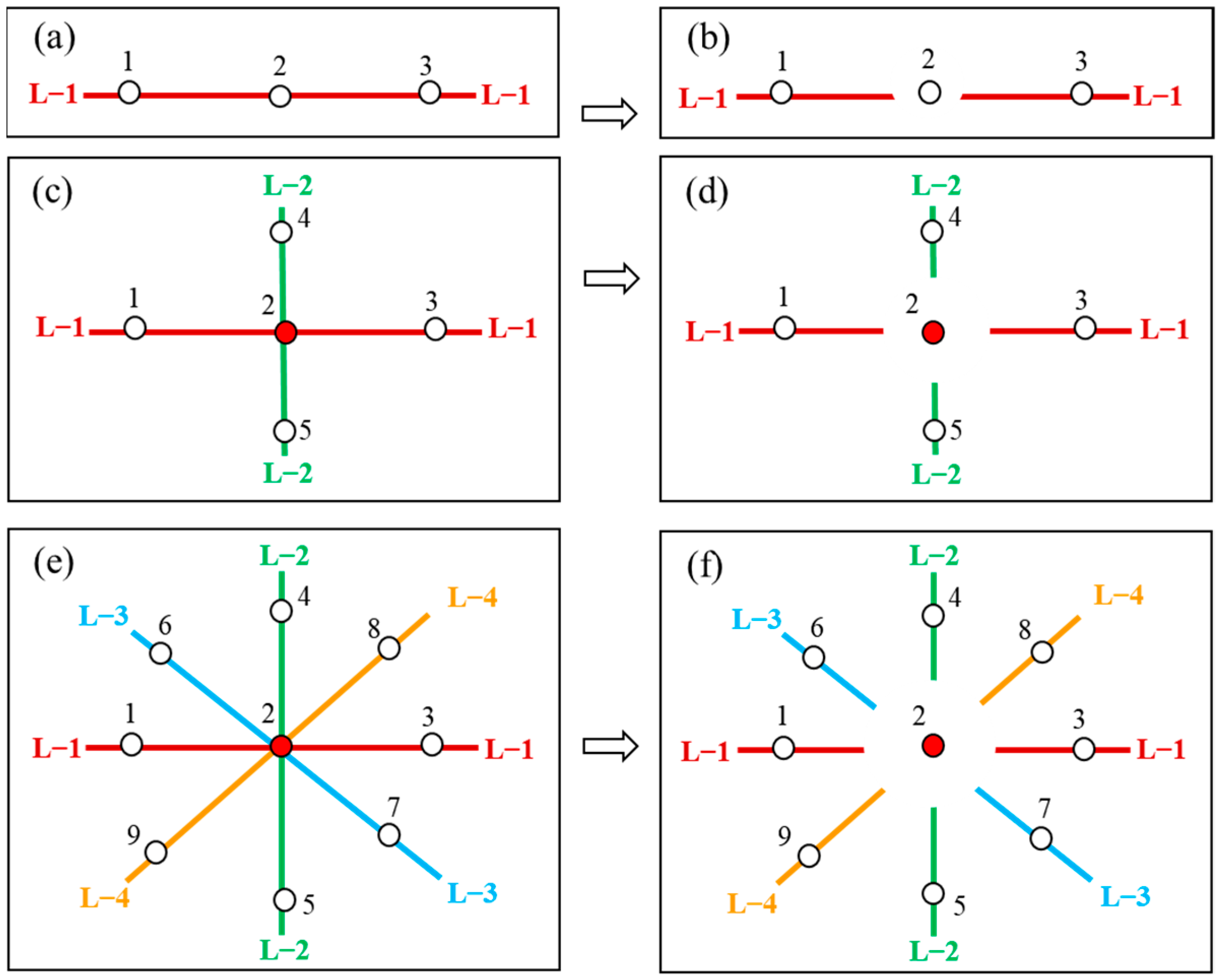
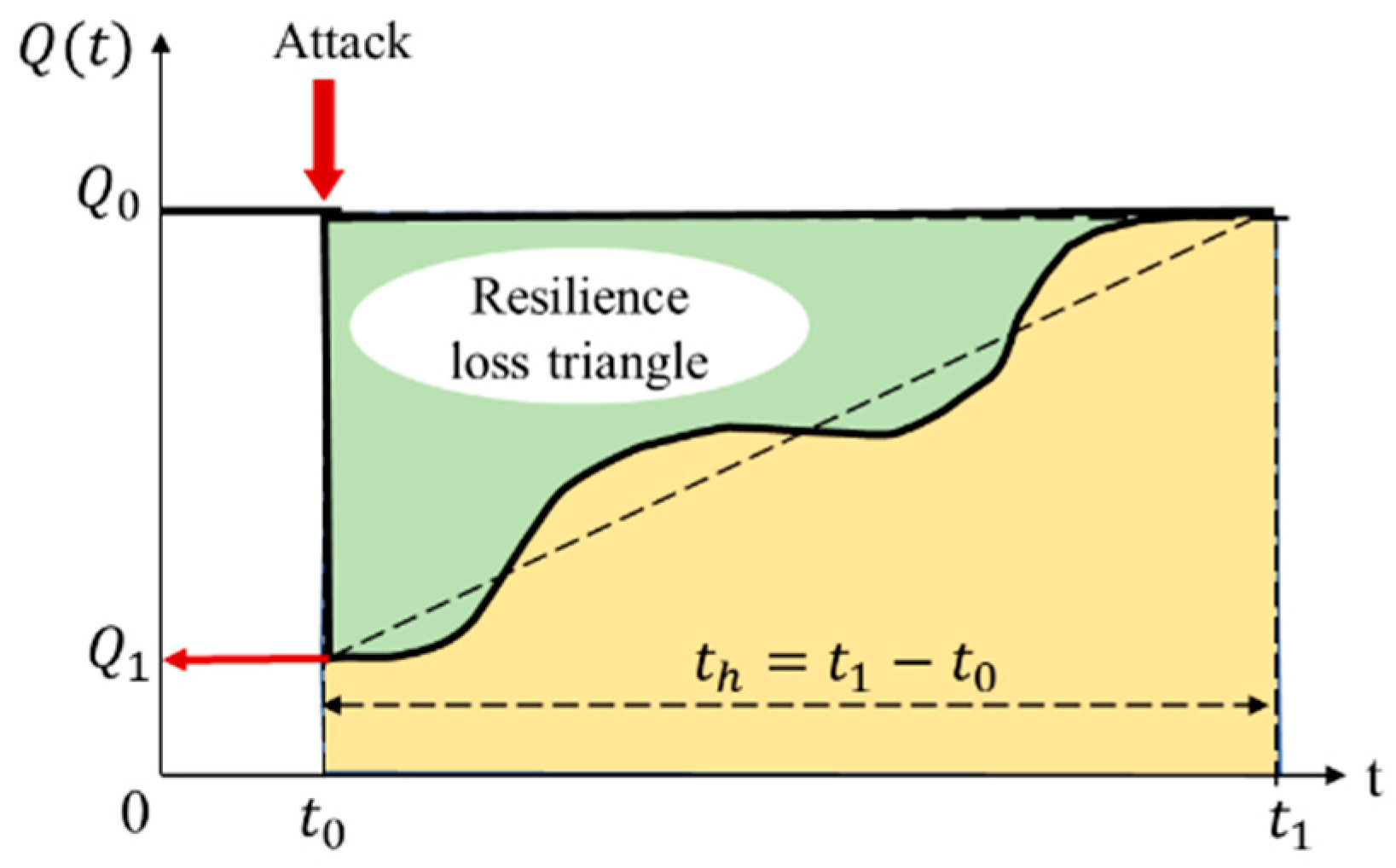

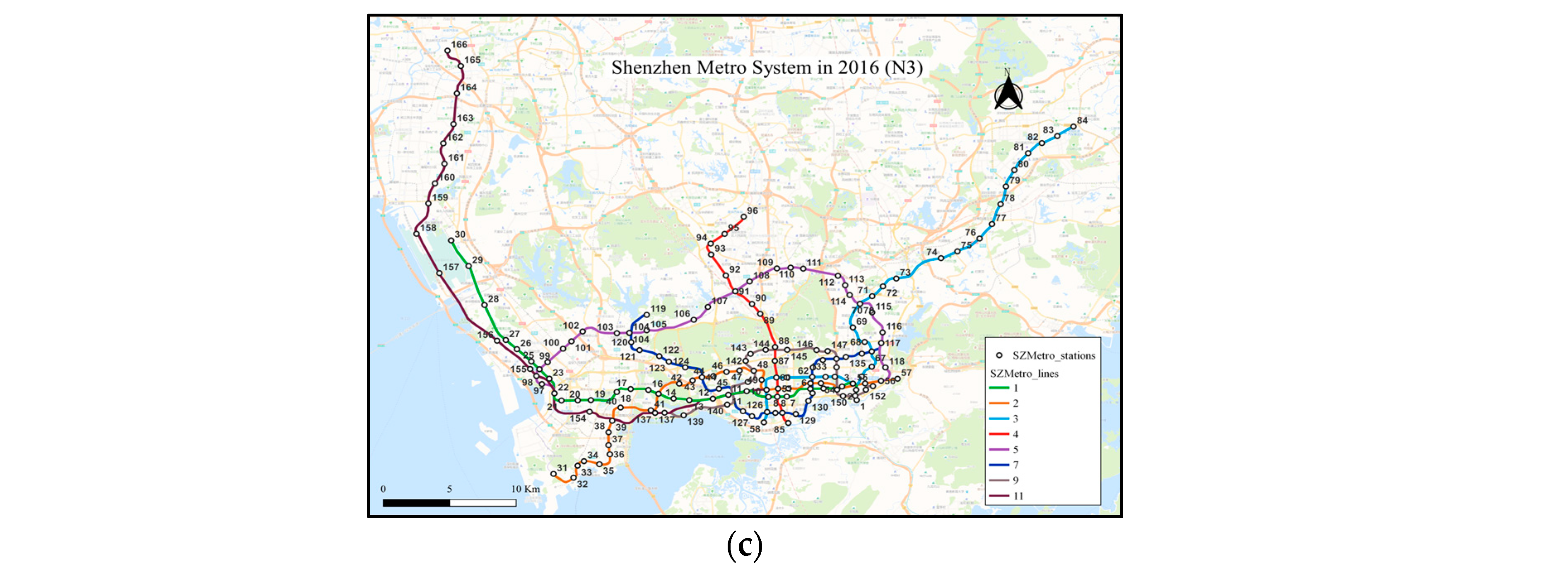
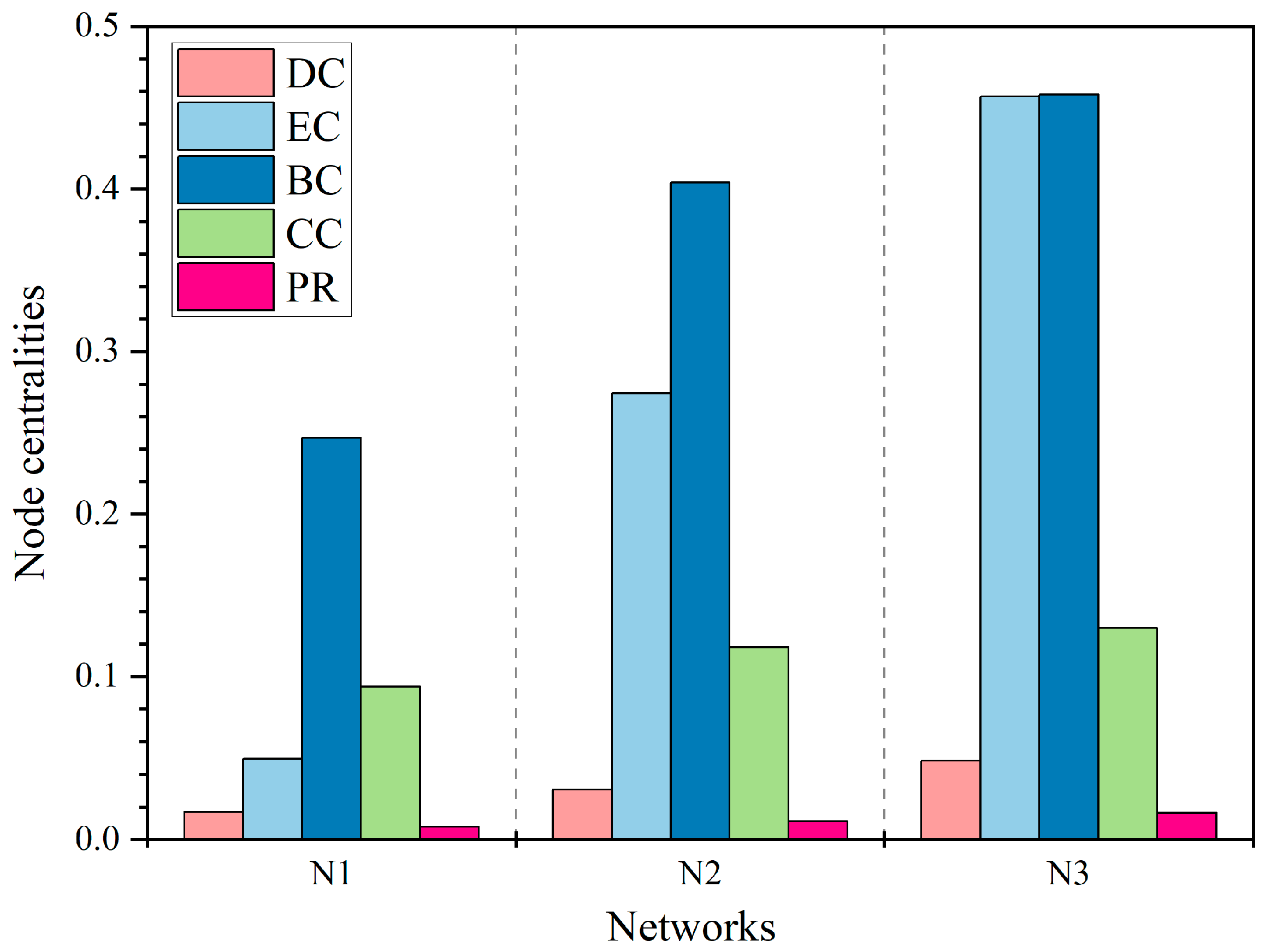

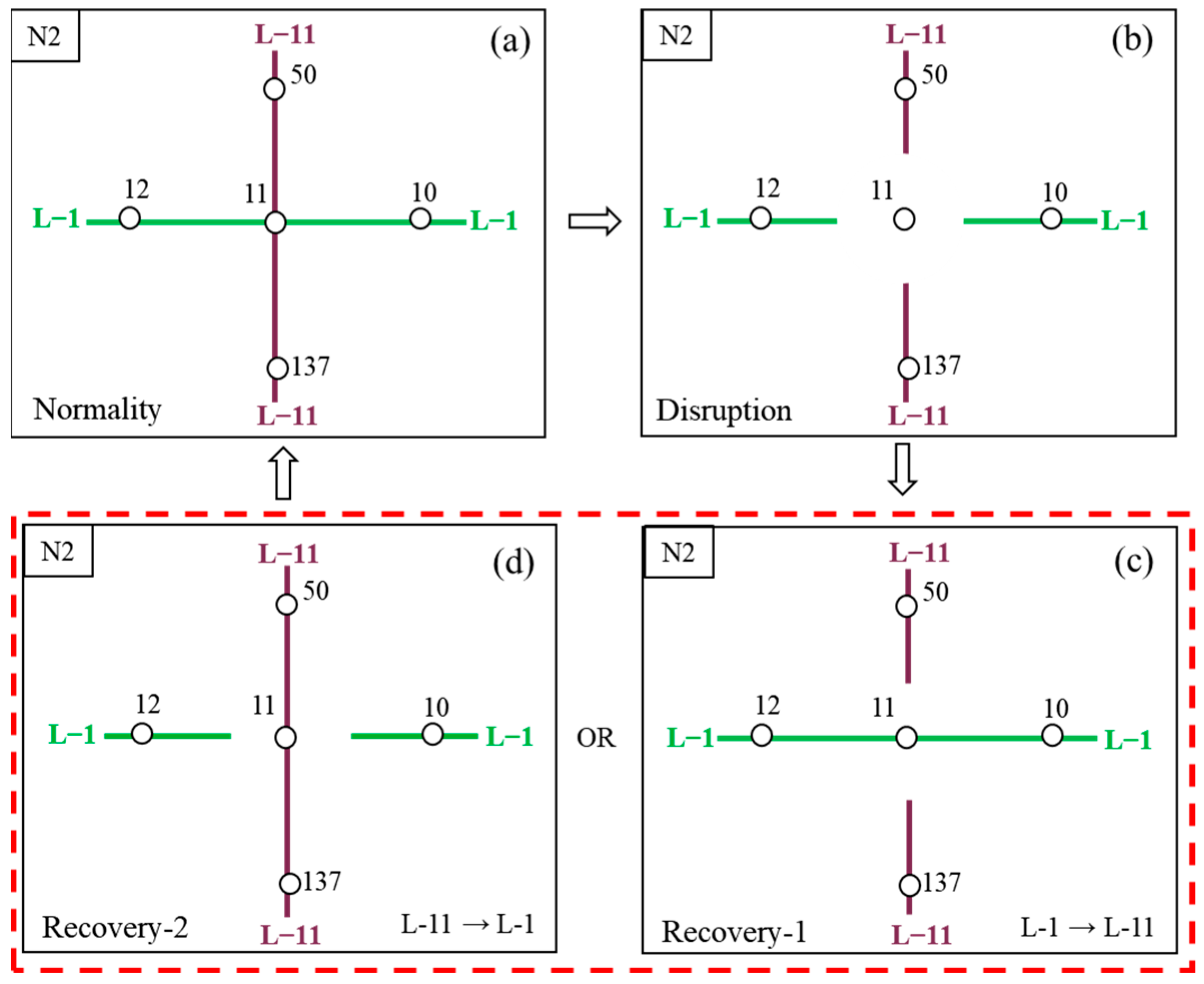
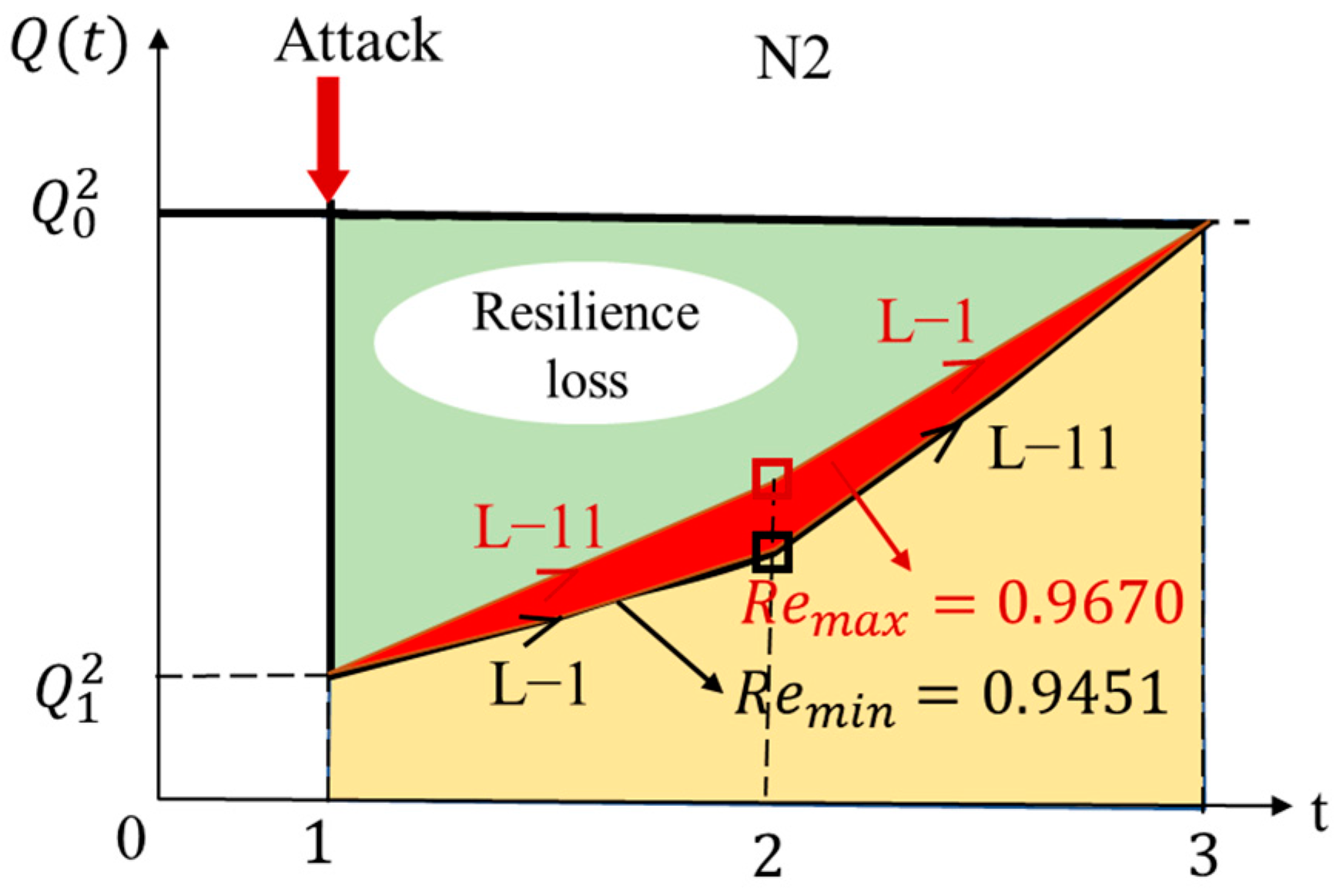
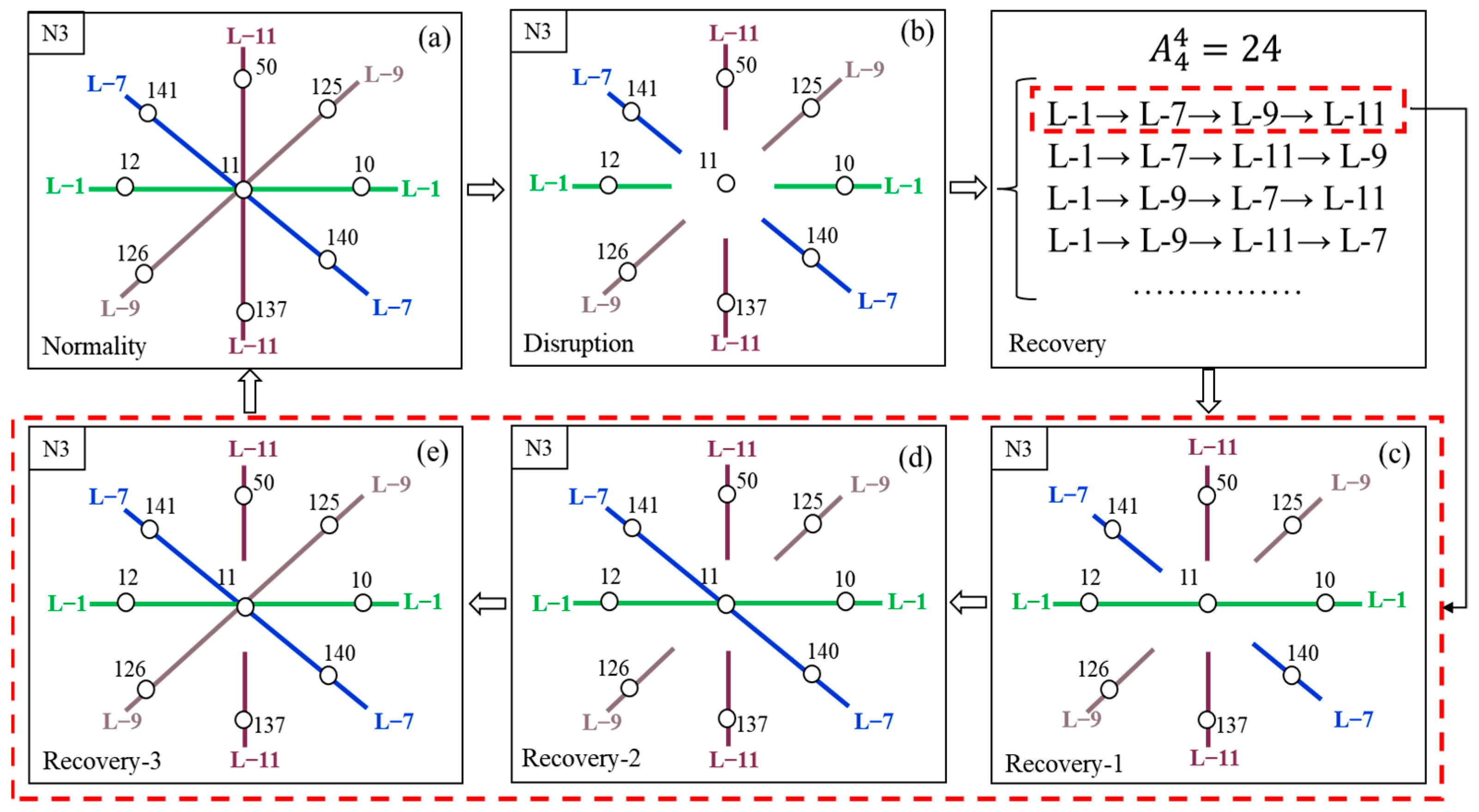
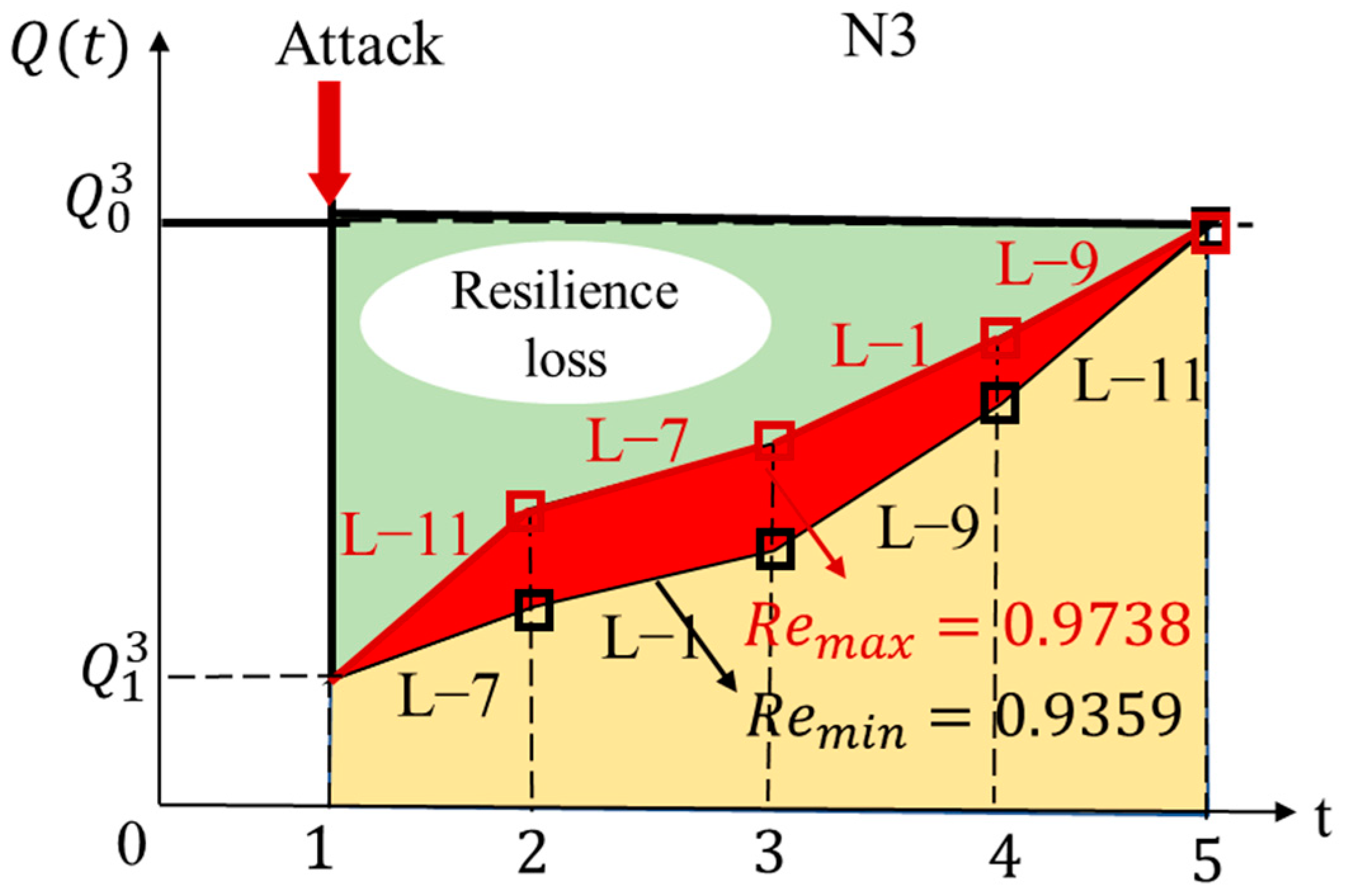
| Index | ||||||||
|---|---|---|---|---|---|---|---|---|
| N1 | 118 | 126 | 13.6177 | 43 | 0.0183 | 0.1534 | 0.0042 | 0.1239 |
| N2 | 132 | 143 | 12.55517 | 43 | 0.0165 | 0.1135 | 0.0033 | 0.1279 |
| N3 | 166 | 190 | 11.64213 | 43 | 0.0139 | −0.0431 | 0.0026 | 0.1323 |
| Index | ||||||||
|---|---|---|---|---|---|---|---|---|
| N1 | 117 | 124 | 14.4219 | 46 | 0.0183 | 0.1318 | 0.0043 | 0.1204 |
| N2 | 131 | 139 | 14.95021 | 46 | 0.0163 | 0.0400 | 0.0038 | 0.1157 |
| N3 | 165 | 182 | 13.20052 | 44 | 0.0135 | −0.1154 | 0.0030 | 0.1194 |
| Sequence | Sequence | Sequence | Sequence | ||||
|---|---|---|---|---|---|---|---|
| 1-11-7-9 | 0.9602 | 11-1-7-9 | 0.9717 | 7-1-11-9 | 0.9467 | 9-1-11-7 | 0.9494 |
| 1-11-9-7 | 0.9578 | 11-1-9-7 | 0.9693 | 7-1-9-11 | 0.9359 | 9-1-7-11 | 0.9410 |
| 1-7-11-9 | 0.9485 | 11-7-1-9 | 0.9738 | 7-11-1-9 | 0.9606 | 9-11-1-7 | 0.9577 |
| 1-7-9-11 | 0.9376 | 11-7-9-1 | 0.9729 | 7-11-9-1 | 0.9597 | 9-11-7-1 | 0.9592 |
| 1-9-11-7 | 0.9491 | 11-9-1-7 | 0.9690 | 7-9-1-11 | 0.9372 | 9-7-1-11 | 0.9392 |
| 1-9-7-11 | 0.9407 | 11-9-7-1 | 0.9705 | 7-9-11-1 | 0.9471 | 9-7-11-1 | 0.9491 |
| Sequence | Sequence | Sequence | Sequence | ||||
|---|---|---|---|---|---|---|---|
| 1-11-7-9 | 0.0211 | 11-1-7-9 | 0.0150 | 7-1-11-9 | 0.0282 | 9-1-11-7 | 0.0268 |
| 1-11-9-7 | 0.0223 | 11-1-9-7 | 0.0163 | 7-1-9-11 | 0.0339 | 9-1-7-11 | 0.0312 |
| 1-7-11-9 | 0.0273 | 11-7-1-9 | 0.0139 | 7-11-1-9 | 0.0209 | 9-11-1-7 | 0.0224 |
| 1-7-9-11 | 0.0330 | 11-7-9-1 | 0.0143 | 7-11-9-1 | 0.0213 | 9-11-7-1 | 0.0216 |
| 1-9-11-7 | 0.0269 | 11-9-1-7 | 0.0164 | 7-9-1-11 | 0.0332 | 9-7-1-11 | 0.0322 |
| 1-9-7-11 | 0.0314 | 11-9-7-1 | 0.0156 | 7-9-11-1 | 0.0280 | 9-7-11-1 | 0.0269 |
| Index | N1 | N2 | N3 |
|---|---|---|---|
| 0.0171 | 0.0305 | 0.0485 | |
| 0.0494 | 0.2743 | 0.4568 | |
| 0.2471 | 0.4038 | 0.4580 | |
| 0.0938 | 0.1179 | 0.1298 | |
| 0.0078 | 0.0112 | 0.0163 | |
| 0.1434 | 0.5831 | 0.9997 | |
| 0.9857 | 0.9560 | 0.9543 |
Disclaimer/Publisher’s Note: The statements, opinions and data contained in all publications are solely those of the individual author(s) and contributor(s) and not of MDPI and/or the editor(s). MDPI and/or the editor(s) disclaim responsibility for any injury to people or property resulting from any ideas, methods, instructions or products referred to in the content. |
© 2023 by the authors. Licensee MDPI, Basel, Switzerland. This article is an open access article distributed under the terms and conditions of the Creative Commons Attribution (CC BY) license (https://creativecommons.org/licenses/by/4.0/).
Share and Cite
Meng, Y.; Zhao, X.; Liu, J.; Qi, Q. Dynamic Influence Analysis of the Important Station Evolution on the Resilience of Complex Metro Network. Sustainability 2023, 15, 9309. https://doi.org/10.3390/su15129309
Meng Y, Zhao X, Liu J, Qi Q. Dynamic Influence Analysis of the Important Station Evolution on the Resilience of Complex Metro Network. Sustainability. 2023; 15(12):9309. https://doi.org/10.3390/su15129309
Chicago/Turabian StyleMeng, Yangyang, Xiaofei Zhao, Jianzhong Liu, and Qingjie Qi. 2023. "Dynamic Influence Analysis of the Important Station Evolution on the Resilience of Complex Metro Network" Sustainability 15, no. 12: 9309. https://doi.org/10.3390/su15129309
APA StyleMeng, Y., Zhao, X., Liu, J., & Qi, Q. (2023). Dynamic Influence Analysis of the Important Station Evolution on the Resilience of Complex Metro Network. Sustainability, 15(12), 9309. https://doi.org/10.3390/su15129309






